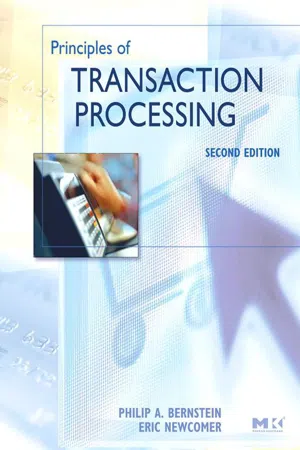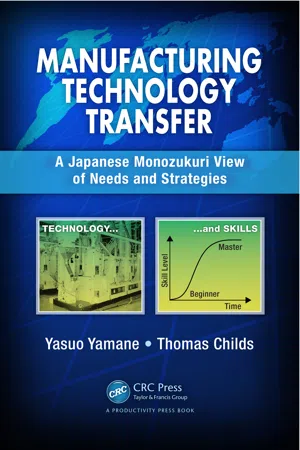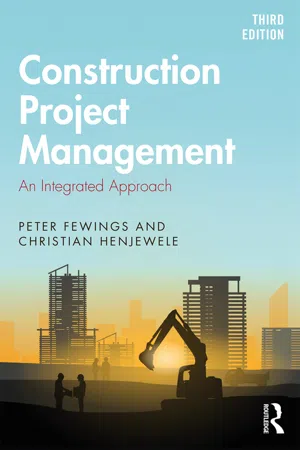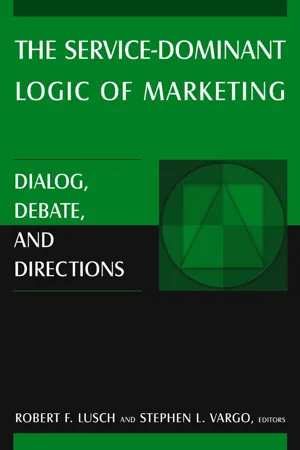Business
Production Process
The production process refers to the series of steps involved in transforming raw materials or inputs into finished goods or services. It encompasses activities such as sourcing, manufacturing, quality control, and distribution. Efficient management of the production process is crucial for optimizing resource utilization and meeting customer demand.
Written by Perlego with AI-assistance
Related key terms
7 Key excerpts on "Production Process"
- eBook - ePub
Operational Performance Measurement
Increasing Total Productivity
- Wilfred Kaydos(Author)
- 2020(Publication Date)
- CRC Press(Publisher)
MEASURING Production ProcessESTHE BUILDING BLOCK OF PERFORMANCE MEASUREMENTThe building block for measuring performance is the “Production Process” shown by Figure 3–1 . The entire production sequence consists of receiving work to be accomplished from a “vendor,” adding value to the product (goods or services) with the Production Process, and passing the modified product on to a “customer,” who may be the end user or just the next step in a chain of events.Figure 3–1Every Business Activity is a Production ProcessEvery business activity is a productiọn process, with vendors and customers that may be unique or shared with other processes. Figure 3–2 shows how the Production Process model can be applied to some common business activities.Figure 3–2Activities as Production ProcessesSince every business activity is a Production Process, a business can be viewed as a complex set of small (micro) processes linked to form larger (macro) processes as illustrated by Figure 3–3 . Some macro processes found in businesses might be order fulfillment, billing, and product design. Micro processes would be activities like checking order specifications, preparing invoices, and drilling holes. “Micro” and “macro” are useful concepts, but they are only relative terms. Unfortunately, there is apparently no term for everything in between.Figure 3–3Any Business is Made Up of Small and Large Processes with Multiple Customers and VendorsThe reason for looking at measurement from a Production Process perspective is that making a product or providing a service is accomplished by processes, which cut across departments or other operating units. As Figure 3–4 - eBook - ePub
- Philip A. Bernstein, Eric Newcomer(Authors)
- 2009(Publication Date)
- Morgan Kaufmann(Publisher)
Chapter 5 Business Process Management5.1 Introduction
A business process is a set of related tasks that lead to a particular goal. Some business processes automate the execution or tracking of tasks using software. Such processes can be modeled as a partially ordered set of steps. Each step may be a transaction, an execution of a program that is not a transaction, an activity performed by a person or machine, or another multistep business process. Business processes are not limited to businesses. They arise in government, academia, science, and many other complex organizations.The term workflow is a commonly used synonym for the concept of a business process. The term business transaction is sometimes used as a synonym for a business process or a step within a business process. Business process management is the activity of creating, managing, adapting, and monitoring business processes. Sometimes a distinction is made between orchestration and choreography , which are essentially business process management within an enterprise and between enterprises, respectively.Much of the work of business process management is comprised of traditional operational activities performed by business managers. This includes defining and organizing the activities of an enterprise, hiring and training people to do the work, developing accounting procedures to measure cost and productivity, and identifying ways of simplifying or automating the work to reduce cost, improve quality, improve customer satisfaction, and so on. These activities are essential ingredients for successful business process management, but they are not our main interest here. Rather, this chapter focuses on aspects of business process management that relate to the choice and use of software.The operation of a large enterprise usually involves hundreds or thousands of business processes. Many of them offer a product or service to a customer of the enterprise, often interoperating with multiple businesses. The following are a few examples: - eBook - ePub
- Daniel Stanton(Author)
- 2017(Publication Date)
- For Dummies(Publisher)
Honestly, a lot of the terminology related to the Make process can be tough for folks to wrap their heads around. And different companies use the same words to mean different things. I’ve kept the definitions simple and provided examples based on things in your daily life, like running a fast-food restaurant. But these exact same terms and concepts are used daily in the supply chains for cars, appliances, microwave dinners, and basically every other product and service that you buy. Of course, the same ideas apply to your supply chain, no matter what type of business you are managing. So throughout the chapter, try think about how each of the topics relates to some part of your own business and whether your Make processes are aligned with what your customers truly value.TECHNICAL DEFINITIONS
The best place to go for precise definitions of most operations management terms is the APICS Dictionary. You can buy a copy of the dictionary from APICS, or you can download the free APICS Dictionary app (formerly called Learn It) that contains all of the same words and definitions. The app also includes quizzes, flashcards, and other activities that can help you build your operations management vocabulary. Visit www.apics.org/apics-for-individuals/apps/apics-learn-it for more information.Planning and Scheduling Production
The process of making anything really starts when you decide what to make, how much to make, and when to make it. In a manufacturing company, this is (conveniently) called production planning and scheduling. Service companies often make life more complicated by finding creative names for this process, but most of them sound a lot like “service planning and scheduling.”If you are working in a services supply chain, try not to get hung up on the word Make. Just remember that the point of any Make process is to transform inputs such as raw materials and technical skills into outputs for a customer. For a doctor, the Make process would be performing a surgical procedure. For an artist it would be creating a painting.Planning production
Before you can create a good production plan you need to take a lot of factors into account. Here are 10 examples of the kinds of information that you really, truly need to consider before you can tell whether a production plan will actually work: - eBook - ePub
Manufacturing Technology Transfer
A Japanese Monozukuri View of Needs and Strategies
- Yasuo Yamane, Tom Childs(Authors)
- 2018(Publication Date)
- Productivity Press(Publisher)
In this first section the activities of production are described from a production management point of view. Section 5.1.1 explains the breadth and scope of production management and the broad demands placed on it. How to satisfy the demands has different constraints and takes different forms, depending on what are the products being manufactured and also what are the products’ quantity and variety. Further details on this topic are given in Section 5.1.2.5.1.1 Production Activities and Management
The activities of introducing a new product to the market need different technologies, depending on the product’s stage of development. It is common to divide development into four stages, as shown in Figure 5.1 . These are research and development (R&D), product development, process development, and finally production itself. The different technologies at the different stages are listed in Figure 5.1 , from core technology to production management technology.In Figure 5.1 the linking of production management technology to production reflects a narrow definition of production management. Production activities depend on the product and process development that have preceded production. The product and process should have been developed with production and its management in mind. Thus, in a wider sense, production management is involved not only with production itself, but also with product and process development. Production management technologies are developed to manage product and process development as well as for managing production itself.From a business point of view, production in an organization can be considered as conversion and value-adding activities. As shown in Figure 5.2 , these start from financing and continue to procurement, production, and sales. From this point of view, technologies for planning and controlling production are only part of production management. It is necessary for production management also to include financing activities, procurement activities, and sales activities.FIGURE 5.1 Activities and their technologies.FIGURE 5.2 Value-added activities in an organization.Within the general activities of management, the purpose of production management is to plan and control production activities to produce products and services economically, with the required quality, at the required quantity, and when needed. With that definition of purpose, the goals of production management can be summarized under the headings of (1) specification and quality, (2) quantity and time, and (3) price. Under these goals, production management must accomplish the following: - eBook - ePub
Understanding the Manufacturing Process
Key to Successful Cad/cam Implementation
- Joseph Harrington Jr.(Author)
- 2020(Publication Date)
- CRC Press(Publisher)
Chapter 12 Production: Conversion of Materials into Products Production of the product is the function that alters the form and character of the input materials into the finished component parts, which then are progressively assembled into the end-product. It is the sixth and last of the six parts of the Production Function. It is shown in Box 6 of Figures 6.5, 9.1, and 9.2. It receives the purchased raw materials and purchased finished components from the Procurement Function, Box 5, as well as production resources from the Resources Function, Box 4. Using the resources, it converts the raw materials into finished parts in accordance with the production instructions received from the Production Planning Function, Box 3, and assembles the parts and the procured components into finished products. When the completed products have satisfactorily passed the acceptance tests, they are delivered to the Marketing Function for distribution to users, as shown in Figure 2.1. This fabrication, assembly, and testing function is complex, and varies widely in its complexity depending upon the product being made and the user industry being served. We discussed the diversity of manufacturing in Chapter 1. Before delving into these details, however, some basic comments are in order relating to the function as practiced in any industry, regardless of the product. Production of parts and products is controlled by several inputs. The overall strategy for production will be determined by the Manufacturing Planning Function, Box 1 of Figure 9.1, as discussed in Chapter 7. The major structural divisions of the product will naturally determine the assembly sequence. The make or buy decisions on components will determine the amount of work to be done in the shop. The manufacturing technologies selected will determine what new facilities-plant buildings, machinery, tooling, and operator skills-if any, must be acquired - eBook - ePub
Construction Project Management
An Integrated Approach
- Peter Fewings, Peter Fewings, Christian Henjewele(Authors)
- 2019(Publication Date)
- Routledge(Publisher)
How? This chapter concentrates on the performance of construction and the potential for continuous improvements in production management. It deals with how the process aspect of the integration model meets the need for innovative solutions to improve performance in the delivery of construction projects. Benefits of both innovation and process improvement are explored from recent industrial reports to identify improvement areas and case studies will be used to highlight best practice.Construction Production ProcessConstruction is the delivery process and is the most visible stage of the project life cycle. Construction implements the design to deliver value for the client. Project management co-ordinates between design solutions and Production Processes to ensure that client expectations are fully met or exceeded. The project manager plans the delivery process, co-ordinates and redresses problems using modern innovations and industrial performance indicators to ensure that the project not only achieves its goals but also creates new innovations for the industry. Construction has always been challenged to improve, and new reports, including the Global Construction Strategy 2025,1 which set improvement goals of reducing total construction time by half at a third of overall cost.For the industry to achieve these improvement targets it has to think beyond its traditional functions and skill base. The strategy recommends five main areas of improvement: developing people in construction, particularly young and talented people; adopting new smart and digital technologies; contributing more to infrastructure-based economic growth; investing more in suitability and efficiency; and providing strong leadership. Limited integration in the production delivery process is the primary cause of inefficiency and waste. Sharing the project’s vision and planning with the supply chain will ensure that subcontractors and suppliers commit to the project to their mutual benefit when they perceive that they are valued and their interests taken care of through partnering. Procurement has a role to play in forging integration among the project team and deciding the nature of relationships that should be built (a topic covered in Chapter 4 ). The benefits of innovation and digital construction technologies, a new and major paradigm shift in the industry for the twenty-first century going forward, is discussed in greater depth in Chapter 13 - eBook - ePub
The Service-Dominant Logic of Marketing
Dialog, Debate, and Directions
- Robert F. Lusch, Stephen L. Vargo(Authors)
- 2014(Publication Date)
- Routledge(Publisher)
Our goal is to present a framework to assist management in the successful adoption of the S-D logic through the implementation of cross-functional business processes. We begin this chapter with a section that describes business process management. Then, we present a framework comprising eight business processes that, when implemented, will integrate activities within a firm and across firms in the supply chain. Next, we describe how the cross-functional business processes are supported by the fundamental premises of S-D logic (Vargo and Lusch 2004). Finally, we present conclusions.Business Process Management
A business process is a structured set of activities with specified business outcomes for customers (Davenport and Beers 1995).1 Initially, business processes were viewed as a means to integrate corporate functions within the firm. Now business processes are used to structure the activities between members of a supply chain. Hammer (2001) points out that it is in the integration of business processes across firms in the supply chain where the real “gold” can be found.The concept of organizing activities as business processes was introduced in the late 1980s and became popular in the early 1990s, after the publication of books by Hammer and Champy (1993) and Davenport (1993) . The motivation for implementing business processes within and across members of the supply chain might be to make transactions efficient and effective or to structure interfirm relationships in the supply chain. The first motivation focuses on meeting the customer’s expectations for each transaction; the second on achieving long-term mutual fulfillment of promises.The transactional view of business process management is rooted in advances in information and communication technology that enable time compression and availability of information throughout the organization (Hammer and Mangurian 1987). This transactional approach to redesigning business processes is based on Taylor’s principles of scientific management, which aim to increase organizational efficiency and effectiveness using engineering principles from manufacturing operations (Taylor 1911). In this case, business process redesign is based on standardizing transactions and the transfer of information (Davenport and Short
Learn about this page
Index pages curate the most relevant extracts from our library of academic textbooks. They’ve been created using an in-house natural language model (NLM), each adding context and meaning to key research topics.






